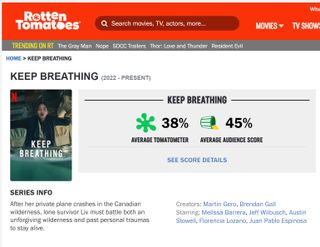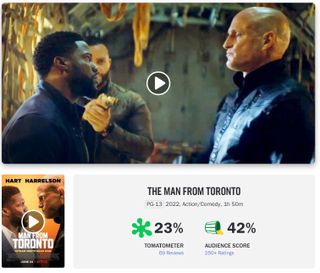Netflix makes bad shows because we'll watch anything
The shows don't have to be good, just there

Not every Netflix show or movie is a Stranger Things, Squid Games, or The Adam Project. Many aren't Ozark, or The OA. Quite a few, in fact, are The Stranger, or any number of other Harlan Coben pot-boiler/head-scratchers. They might also be a Keep Breathing or Man from Toronto.
But what all Netflix content has in common, at least by my reckoning, is that we watch it.
Sometimes I joke that none of us are satisfied until we've reached the theoretical end of Netflix, that dark space at the bottom of the deep well of Netflix content. It's cold, hard, dank, and if there's a scrap of something new clinging to that foundation, we'll watch that, too.
A question of quality
Does quality matter? I think it matters to Netflix and subscribers in equal measure, but each side is dealing with some intractable problems, which means that the basis for whether or not something is made or your watch is not always quality.
For Netflix, it has over 221M subscribers to satisfy, a gaping maw of content consumerism that devours fresh-cooked content moments after Netflix pulls it from the production oven.
For consumers, they spend far more time than ever in front of the screen, desperate for the distraction Netflix promises and often frustrated when there doesn't seem to be anything new.
With Netflix spending $17B or more a year on new TV series, reality shows, and theatrical-grade movie releases, that notion is inconceivable. As I see it, Netflix has found a way to fill the insatiable demand, which is to create a murky blend of high-quality and low-rent entertainment.
Subscribers, though, no longer seem to care.

Rotten fruit
I started going back through some of the Popular Now and Trending content on Netflix and found that, while there are many shows that achieve 80%+ critics and audience ratings on Rotten Tomatoes, there are quite a few that wallow below 50%.
Survivalist tale Keep Breathing has an abysmal 38% Rotten Tomatoes critic score and just a 45% audience score. Naturally, it's a Top 10 show on Netflix because it's new, available, and, in a sort of self-fulfilling prophecy kind of way, popular because it appears in the Top 10.

When you're doom-scrolling through Netflix in a desperate search for your next binge fix, the first thing you see is what the majority of other people are watching. For all the vastness of the Netflix content library, it's very much like your local cineplex with a small handful of options listed on the marquee. The rest of Netflix is then like a behind-the-curtain backroom that you only visit if you want to take your chances.
Or take a movie like the Kevin Hart, Woody Harrelson starrer, The Man from Toronto. It has one of the worst Rotten Tomato ratings I've seen in some time, just 23% on the Tomatometer, and, from the audience who sat through it, just 42%. Yes, it's a Top 10 on Netflix, but it also follows another Netflix and, I'd say, broader TV and movie consumption trend: audiences almost invariably rate the content more highly than the more discerning critics.
Not only do low ratings not matter, but no rating at all is also immaterial. If something is new and available to stream on Netflix, it will be consumed. Look, for example, at Extraordinary Attorney Woo. It has no Rotten Tomatoes score, and, based on the Audience rating, no one loves it. Yet, it's still a Top 10 show.

You'll watch anyway
That's fine. Audience acclaim is what really counts, anyway. But I have the distinct feeling that as competition increases along with demand for more content, we will see diminishing content quality returns.
Shows that might not have made it past quality gatekeepers in the past will get dumped on to Netflix with the knowledge that an audience-feeding frenzy will ensue, whether or not the show/movie is any good.
A Netflix show has 38% on Rotten Tomatoes. Do youAugust 1, 2022
When I asked in a Twitter Poll what people would do if they saw a Netflix show with a 38% Rotten Tomatoes score, the majority said they would still give it a one-episode tryout (they were trailed closely by 34% who said they'd avoid it at all costs).
That's all Netflix really needs to prove its formula is working. If you watch just one episode of a poorly rated show right after it launches, that show is sure to be in the Top 10 or, at least, Trending Now (which is right below Popular on Netflix). Once you have that, you've launched the cycle where subscribers will see that a lot of people are watching the new show. So they'll try it too. Soon, it's truly popular and, despite the awful ratings, somewhat inescapable.
I'm not immune to this trend and, as 6% of respondents told me, I'll probably hate watching it on Netflix, too.
Get daily insight, inspiration and deals in your inbox
Get the hottest deals available in your inbox plus news, reviews, opinion, analysis and more from the TechRadar team.

A 38-year industry veteran and award-winning journalist, Lance has covered technology since PCs were the size of suitcases and “on line” meant “waiting.” He’s a former Lifewire Editor-in-Chief, Mashable Editor-in-Chief, and, before that, Editor in Chief of PCMag.com and Senior Vice President of Content for Ziff Davis, Inc. He also wrote a popular, weekly tech column for Medium called The Upgrade.
Lance Ulanoff makes frequent appearances on national, international, and local news programs including Live with Kelly and Ryan, the Today Show, Good Morning America, CNBC, CNN, and the BBC.
